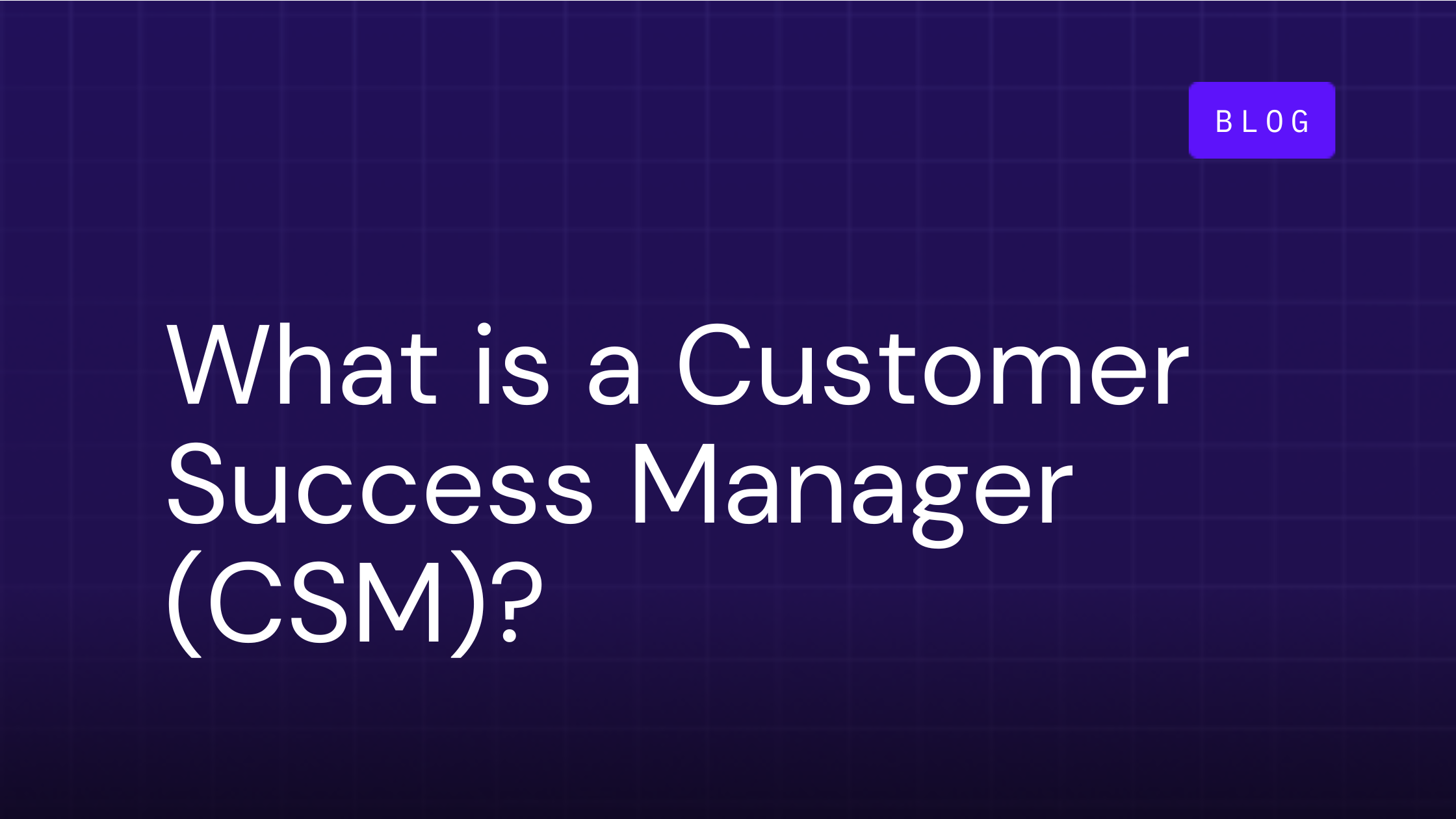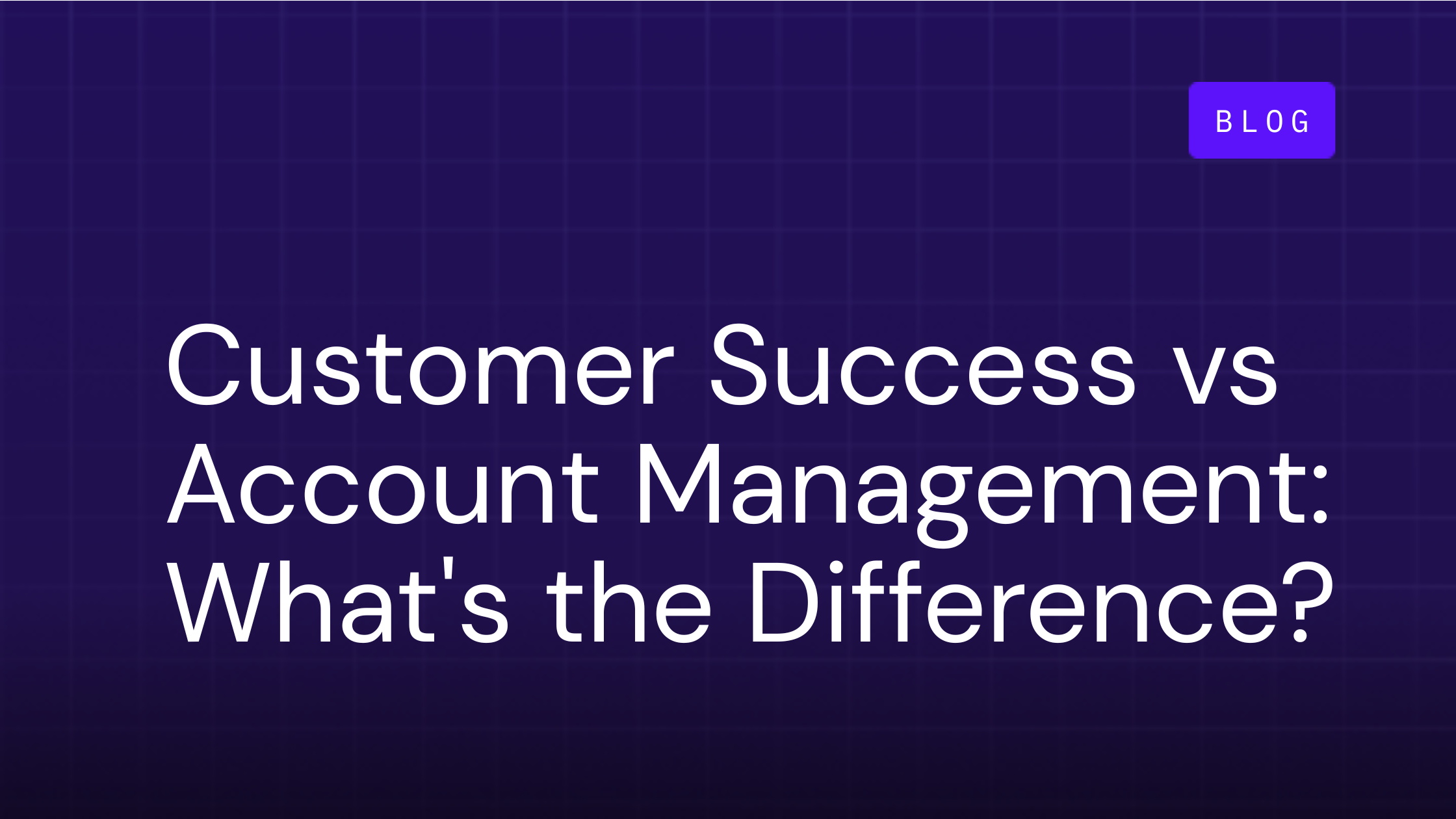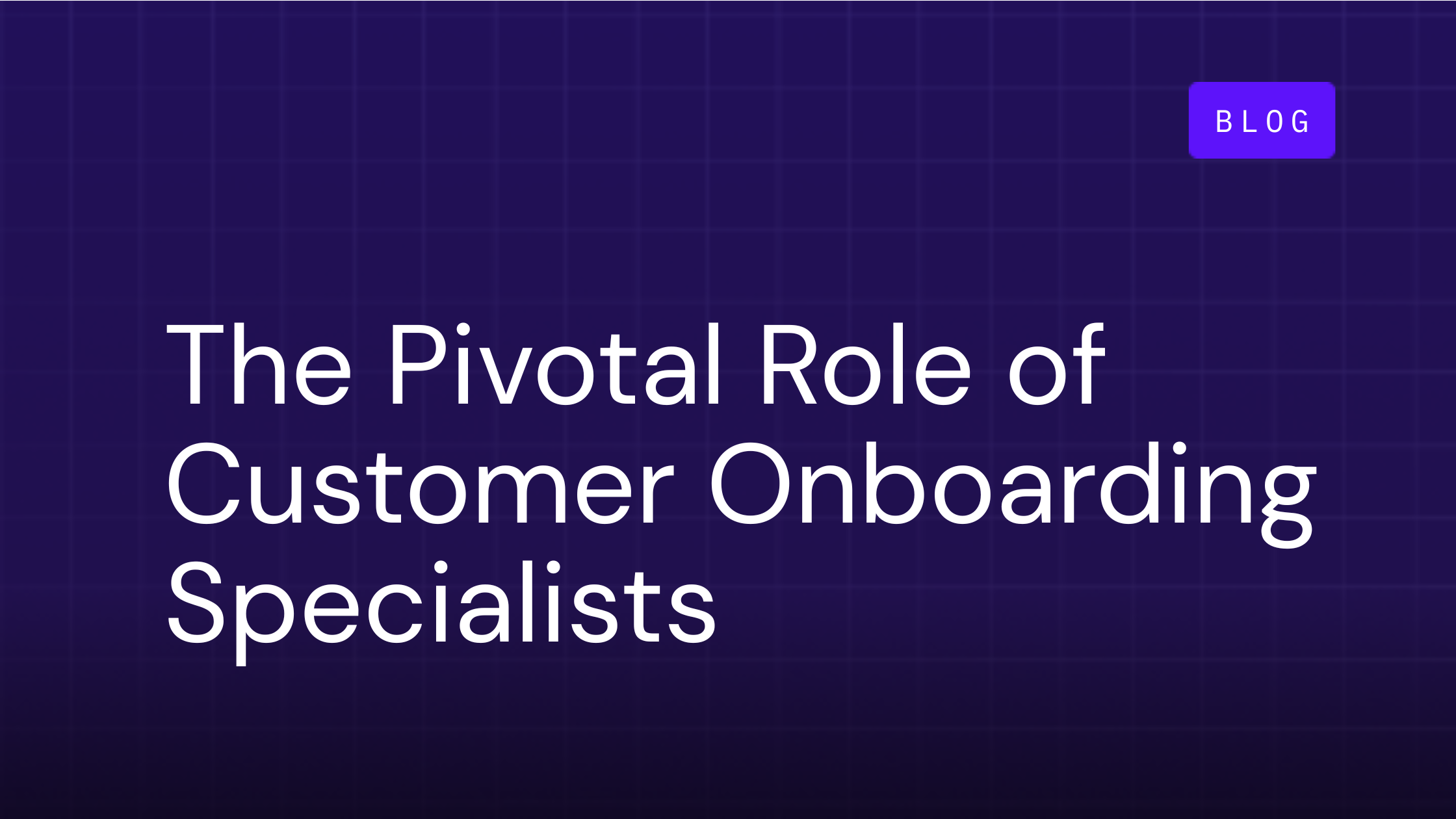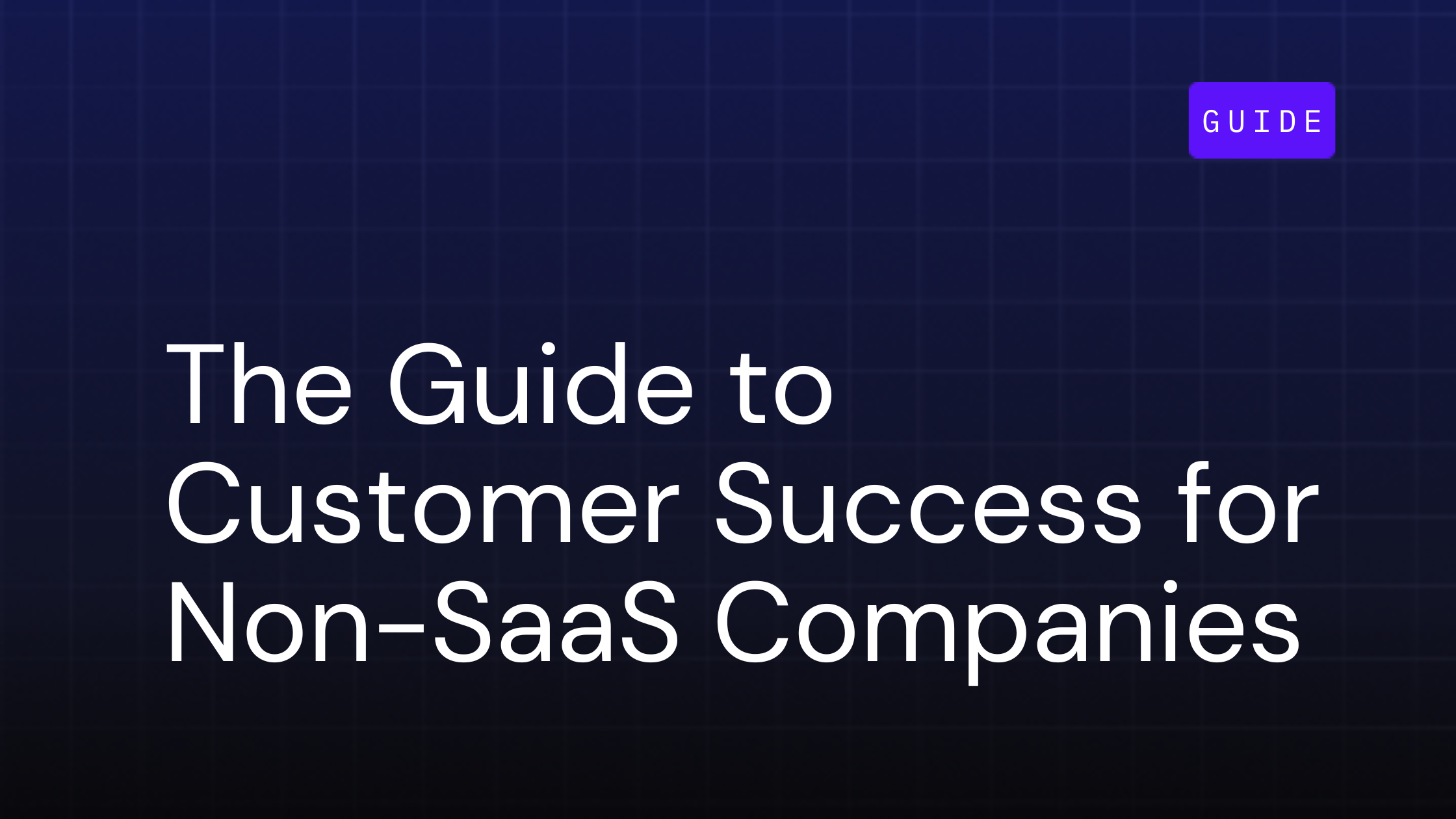What is a Customer Success Manager (CSM)?
Published: May 28, 2024

Table of Contents
The heart of modern customer engagement strategies lies with the Customer Success Manager (CSM) — a role dedicated to helping clients succeed and fostering strong, long-term relationships. As companies increasingly prioritize customer satisfaction and retention, the CSM makes sure that clients achieve their desired outcomes while using a product or service.
This blog will guide you in learning what a CSM is, what they do, the skills they need, and the impact they can have on a business. You’ll have a solid understanding of why the CSM role is so valuable in today’s business landscape and how it can help your organization thrive.
What Is a Customer Success Manager?
A CSM is the glue that holds a company and its customers together. Their main goal is to make sure customers are getting the most out of the products or services you offer, which leads to high levels of satisfaction, loyalty, and growth for the business. What sets CSMs apart from traditional customer support roles is their proactive approach. CSMs don’t just wait for problems to happen — they anticipate needs and tackle potential issues before they arise.
What Are the Key Responsibilities of a CSM?
A CSM role can be challenging, but anyone with dedication and a desire to help others can master the key responsibilities to make a true impact.
Onboarding
When a new customer comes on board, the CSM guides them through the setup process. They make sure the customer knows how to properly use the product, setting them up for success right from the start. OnRamp makes this process a breeze with its comprehensive project portal that boosts customer engagement and satisfaction, making it easier for CSMs to support a client’s success.
Building Long-Term Customer Relationships
CSMs cultivate solid relationships through regular check-ins, personalized communication, and being the go-to person for any questions or concerns. By building a personal connection with each customer, CSMs can tailor their support to fit individual needs and preferences., making the overall customer experience even better.
Advocating for the Customer
Within your company, CSMs are the voice of the customer. They take feedback to the product development teams, shine a light on common pain points, and champion features or improvements that would make the customer experience even better. This internal advocacy makes sure that customer needs are always front and center in business decisions.
Proactively Addressing Customer Needs
CSMs keep a close eye on how customers are using the product and how engaged they are. They can spot and resolve potential problems before they become significant roadblocks, making for a smoother journey for the customer.
What Makes a CSM Different From Other Roles?
Although every role in a company plays a vital part, CSMs bring a unique blend of skills that nurture long-term relationships in ways that complement and enhance the work of their colleagues.
Customer Success vs. Customer Support
Both roles are all about helping customers, but they go about it in different ways. Customer support is like a firefighter, reacting to issues as they come up. But, customer success is more like a fire prevention specialist, working to stop problems before they start and making sure customers are using the product to its fullest potential.
Customer Success vs. Account Management
Account managers are often the money folks, handling sales and making sure contracts get renewed. CSMs are more concerned with the customer’s overall success with the product, making sure they’re getting the results they want. While account managers often work hand-in-hand with the sales team to manage the business side of things, CSMs are all about helping customers win with the product.
10 Common Key Metrics for a CSM To Own and Optimize
1. Reduce Churn
Churn is the rate at which customers leave your business. High churn? That's a real headache for your revenue and growth.
First off, don't wait for problems to knock on your door. Get out there and check in with your customers regularly. It's all about being proactive. And remember, one size doesn't fit all. Tailor your support to each customer's unique needs.
Here's a pro tip:
- Use data to your advantage.
- Set up an early warning system to spot customers thinking of leaving.
- Remember to keep those feedback channels wide open.
If a customer's unhappy, you want to know about it ASAP.
2. Increase Customer Lifetime Value (CLV)
CLV is all about the long game. It's the total cash a customer brings in throughout your relationship.
Think about upselling and cross-selling. But don't be pushy — offer products that genuinely add value for your customers. Knowledge is power, right? Make sure your customers know all the cool things your product can do. Run some training sessions, then share some resources.
Don't be shy about showing off the return on investment your customers are getting. Have a solid game plan in place to earn renewals. The longer they stick around, the higher that CLV goes!
3. Foster Long-Term Customer Relationships
Building lasting relationships is like tending a garden: It takes time and care. Stay in touch with your customers regularly, but make it meaningful. Get to know them as people, not just account numbers.
Why not start a customer advocacy program? Your happy customers could become your best marketers. And speaking of engagement, mix it up a bit. Host webinars, create user groups, or set up community forums.
Don't forget to share some brain food — industry insights, best practices, that sort of thing. Everyone likes a pat on the back, right? Consider setting up a program to recognize and reward your loyal customers.
4. Drive Customer Success
Your job doesn't end when a customer signs up. In fact, that's when the real work begins. Create a killer onboarding program to help newbies hit the ground running. But don't stop there. Offer ongoing training to help them squeeze every drop of value from your product.
When problems pop up (and they will), be ready to swoop in with swift, effective support. At the same time, give your customers the tools to help themselves. A good knowledge base can work wonders. And keep an eye on those customer health scores — they're like the pulse of your customer relationships.
5. Act as a Liaison Between Customers and the Company
You're the customer's voice inside your company. Use your ears! Gather feedback through surveys, chats, or even a quick coffee. Then, make sure that feedback doesn't gather dust. Be the champion your customers need, pushing for their ideas in product development meetings.
Don't be a lone wolf. Work hand in hand with other teams — sales, product folks, marketers, support staff. When everyone's on the same page, magic happens. Your insights from the frontlines can shape the product roadmap, ensuring your company stays on track with what customers want.
6. Boost Customer Satisfaction and Loyalty
CSAT and NPS aren't just fancy acronyms. They're your crystal ball into customer happiness. Keep a close eye on these scores. They'll tell you if you're on the right track or need to switch gears.
But here's the thing: Don't just collect data. Use it! Set up a feedback loop that never stops. When customers talk, listen. Then act. Rinse and repeat. And when you earn a win, shout it from the rooftops! Share those customer success stories. Nothing sells quite like happy customers singing your praises.
7. Facilitate Customer Feedback and Insights
Feedback is gold, folks. So, mine it from everywhere — surveys, social media, chats, even how customers use your product. Get up close and personal with your key customers. Set up feedback sessions that dig deep.
Now, what do you do with all this feedback? Look for patterns. What are customers saying over and over? These trends are your North Star for making intelligent moves. And when customers speak up, show them you're listening. Cook up action plans based on their input. It's like telling them, "Hey, we hear you, and we're on it!"
8. Promote Customer Empowerment
As the saying goes, "Give a man a fish, and you feed him for a day. Teach a man to fish, and you feed him for a lifetime." That's what we're going for here. Build a knowledge base that's a treasure trove of info. Throw in some tutorials for good measure. Your goal is to turn your customers into product ninjas who can tackle issues independently.
Written resources are nice, but a more effective strategy is to fire up some webinars and workshops. Show your customers how to squeeze every drop of value from your product. And here's a cool idea: Create a space where your customers can help each other out. An online forum or a peer support network can work wonders. It's like creating a community of super-users who have each other's backs.
9. Drive Innovation Through Customer Insights
Your customers are sitting on a goldmine of ideas. Why not tap into that? Set up a customer advisory board. It's like having a brain trust of your best customers helping to shape your product's future. And if you're feeling brave, try some co-creation. Get customers involved in dreaming up new features. After all, who knows what they need better than they do?
When cooking up something new, get your customers to taste-test it. Beta testing isn't just about finding bugs — it's about ensuring you're on the right track. Use these insights to keep improving. Your product should evolve as your customers' needs do.
10. Enhance Customer Onboarding Experience
First impressions matter. Make your onboarding process shine. Create a welcome program that makes new customers feel like VIPs. Give them a roadmap with a detailed checklist. It's like giving them a GPS for your product. No one likes feeling lost.
Remember, every customer is unique. So why should their training be one-size-fits-all? Tailor your onboarding to fit each customer's needs. Consider assigning onboarding specialists. It's like giving each new customer their own personal guide.
Keep the lines of communication open during onboarding. Schedule check-ins to make sure everything's smooth sailing. And don't forget to measure how well you're doing. Track things like how quickly customers start seeing value, or how many finish the onboarding process. These metrics are your report card — use them to keep getting better.
15 Essential Skills for a Customer Success Manager
1. Customer Relationship Management
Think of yourself as a relationship guru. You're not just managing accounts — you're building connections. It's about being a good listener and showing genuine empathy. Remember, your customers are people, not just numbers on a spreadsheet.
2. Technical Knowledge
You've got to know your product inside out. Be the go-to expert who can explain complex features in simple terms. Your goal? To turn your customers into power users who can't imagine life without your product.
3. Analytical Skills
Time to put on your detective hat. Dive into the data and uncover those hidden gems of insight. But don't stop there - use your knowledge to solve problems before they pop up. It's like being a fortune teller, but with spreadsheets!
4. Communication Skills
Whether you're chatting face-to-face or firing off an email, your words matter. Be clear, concise, and compelling. When it comes to tech talk, think of yourself as a translator, turning jargon into plain English.
5. Time Management
Juggling multiple accounts? It's like being a plate spinner in a circus. You've got to keep everything moving without letting anything crash. Prioritization is your secret weapon here.
6. Problem-Solving Ability
When issues crop up (and they will), you need to be Johnny-on-the-spot with solutions. Think of yourself as a customer service superhero, swooping in to save the day. When conflicts arise, you're the peacemaker who turns grumpy customers into happy campers.
7. Project Management
You're the captain of the customer success ship. Chart the course, rally the crew (your internal teams), and steer towards those customer satisfaction goals. It's about making promises and delivering on them.
8. Adaptability
The only constant in business is change, right? So be like water: fluid and adaptable. When customer needs shift or feedback rolls in, be ready to pivot. Thrive in that fast-paced environment. It keeps things exciting!
9. Negotiation Skills
Time to channel your inner diplomat. Whether you're working on renewals or exploring upsell opportunities, aim for that win-win. You're the one finding the middle ground that makes everyone happy.
10. Customer Advocacy
You're the customer's champion inside your company. Bring their voice to the table in product meetings. Fight for features they need. Remember, happy customers make for a healthy business.
11. Sales Acumen
No, you're not in sales, but a little sales know-how goes a long way. Understand the process and know how to speak the lingo. Always be on the lookout for opportunities to grow accounts. It's not about being pushy — it's about finding ways to add value.
12. Collaboration
You're the bridge between customers and...well, everyone else in your company. Product team, marketing, support, you name it. Foster those relationships. When everyone's working together, that's when the magic happens.
13. Strategic Thinking
Don't just think about today. Plan for tomorrow. How can you make customers even happier next quarter, or next year? Align your customer success goals with the big picture of your company's direction.
14. Resilience
Some days will be tough. Customers might be upset, and goals might seem out of reach. That's when you need to dig deep. Stay positive, stay focused. Remember why you're doing this: to help customers succeed.
15. Product Knowledge
Last but not least, know your stuff. Your product, your industry — be the expert. Stay curious and keep learning. When a new feature drops or an industry trend emerges, be the first to know and understand how it impacts your customers.
Tools and Technologies for Customer Success
As a CSM, you'll rely on a suite of tools to effectively manage customer relationships:
- CRM software: Your central hub for tracking customer interactions and data. It allows you to comprehensively view each customer's journey and needs.
- Data analytics tools: Key for uncovering insights into customer behavior. These help you spot trends and make data-driven decisions to improve customer outcomes.
- Communication platforms: Whether it's email, chat, or video conferencing, these round out your toolkit and ensure you're always connected with your customers in the most effective way.
Measuring Success as a CSM
Success in customer success management is all about metrics:
- CSAT gives you direct feedback on how well you're meeting customer expectations.
- NPS indicates how likely your customers are to recommend you to others.
- Customer retention rates are a key indicator of long-term success. After all, getting new customers is often more costly than keeping existing ones.
The key is regularly reviewing these metrics and adapting your strategies based on the data and feedback you receive. Continuous improvement is the name of the game in customer success.
Steps to Becoming a Customer Success Manager
So, you're interested in joining the customer success world. Here's your roadmap.
First up, education. Most CSM positions look for a bachelor's degree. Business, marketing, communications — these are all great foundations. But don't worry if your degree is in something else. It's the skills and knowledge you've gained that really matter.
Next, it's time to get some hands-on experience. Start in customer-facing roles like customer service or sales. Think of it as your training ground — you'll learn to solve problems and keep customers happy. It's where you'll start building your customer success toolkit.
Finally, commit to continuous learning. Dive into training programs and pursue relevant certifications. The customer success field is always evolving, so you've got to stay on your toes.
Remember, becoming a great CSM isn't just about ticking boxes. It's about having a genuine passion for helping people, a talent for creative problem-solving, and a drive to keep improving. If you've got those qualities, you're already well on your way!
What Are the Career Growth Opportunities for a CSM?
A CSM career path typically starts with entry-level roles in customer support or service, addressing customer issues. From there, they can move into a CSM position, focusing on proactive engagement and customer success.
With proven success, they can advance to senior CSM roles and team lead positions to manage key accounts and mentor junior CSMs. Eventually, they can move into executive roles such as Director of Customer Success or Chief Customer Officer. People in these positions are responsible for the overall customer success strategy and team performance.
What Is the Average Salary for CSMs?
The average salary of a CSM can vary widely based on factors such as experience, industry, and location. On average, entry-level CSMs can expect to earn between $50,000 and $70,000 per year. Mid-level CSMs typically earn between $70,000 and $100,000, while senior CSMs and those in leadership positions can earn upwards of $100,000 to $150,000 or more.
Resources for Salary Information
For more detailed info, check out industry reports, salary surveys, and job boards. These resources can also help you negotiate your salary and compensation packages when you're job hunting:
- Glassdoor -Glassdoor Salaries
- Provides salary information based on employee reports and company reviews.
- Payscale -Payscale
- Features a comprehensive salary survey and reports across various industries and job roles.
- Indeed Salary -Indeed Salaries
- Aggregates salary data from job listings and employee reviews.
- Bureau of Labor Statistics (BLS) -BLS Occupational Employment Statistics
- Provides official salary statistics and reports for a wide range of occupations in the U.S.
When Should You Hire a CSM?
If one of your objectives is to keep and nurture the customers you already have while bringing in new ones, it’s time to consider hiring a CSM. This is especially true for SaaS companies and those with complex products that need ongoing support and engagement to make sure customers are successful.
A CSM can have a genuine impact on your company’s future. They help keep customers from jumping ship and increase the value of each customer over time. By making sure customers are happy and thriving, CSMs help build a loyal customer base — the foundation for sustainable growth.
With their onboarding platform, OnRamp can help you set a CSM up for success.
Conclusion
A Customer Success Manager is a must-have if your company cares about building lasting relationships with customers and making sure they get the most value possible. CSMs are proactive heroes who engage with customers, tackle their needs head-on, and champion their cause within the company. They’re the ones who drive satisfaction, keep customers coming back, and help the business grow. Investing in customer success by bringing on dedicated CSMs is a smart move that can seriously boost overall performance and customer loyalty.
Related Posts:

Customer Success vs Account Management: What's the Difference?
For most tech companies, two roles often serve at the forefront of client engagement: the account manager and the customer success...

Unlocking Success: The Pivotal Role of Customer Onboarding Specialists
Who exactly should take the reins when it comes to customer onboarding?

The Guide to Customer Success for Non-SaaS Companies
We talk often about customer success for software-as-a-service (SaaS) businesses due to the recurring nature of subscription-based...